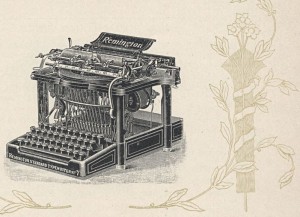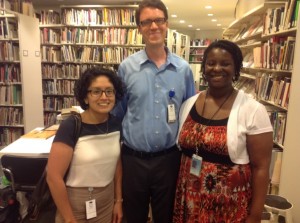Originally from Nebraska, Lesley Parilla is our new cataloger for the Field Book Project. Her first position at the Smithsonian was as a volunteer at the National Museum of Natural History, where she met the staff establishing the Field Book Project. Lesley soon became the first contractor hired for the Project and helped develop its initial cataloging procedures and workflow. The Project then migrated to the Smithsonian Institution Archives, until the summer of 2014 when it officially became part of the Smithsonian Libraries and Biodiversity Heritage Library.
Category: Staff Notes
When asked about her role as the Smithsonian Libraries’ program coordinator, Susan Frampton retorts, “Well, this week I’ve chased down old photos of women with dead birds on their hats.” The truth is, there is no ordinary day for Susan; she’s like a cook who has many pots on the burner at once, and it’s a lucky day when there are no stray fires to extinguish. She regularly collaborates with Libraries staff, as well as with colleagues around the Institution and beyond.
Julia Blase is originally from Tucson, Arizona. She moved to D.C. in 2013 as part of the Library of Congress and the Institute of Museum Library and Services’s National Digital Stewardship Residency program, where she led a digital asset management project for the National Security Archive. Prior to D.C. she lived in Denver, Colorado, where she was pursuing her master of library and information science from Denver University while managing the Denali Centennial online exhibit project at the American Alpine Club Library. She also earned a master’s degree in management from the Fuqua School of Business and a bachelor’s degree in art history from Duke University.
 The post was written by Gil Taylor and Keri Thompson and was originally featured on our Tumblr page.
The post was written by Gil Taylor and Keri Thompson and was originally featured on our Tumblr page.
Last year, our reference team received an interesting query from a student of cultural anthropology wanting ”to find out if any of the Smithsonian employees have published a work of fiction?”
Boy, and have they! In case you needed some end-of-summer reading suggestions, here is a list of fiction works by former or current Smithsonian staff compiled by Gil Taylor, NMNH Librarian.(current as of February, 2013.)

This post was written by Salima Appiah-Duffell, library technician at the Smithsonian American Art Museum/National Portrait Gallery Library and Hirshhorn Museum and Sculpture Gallery Library. Salima recently joined our staff in July. Welcome, Salima!
When I started library school at Catholic University, working at the Smithsonian (Institution) seemed like a beautiful, but impossible dream. Now, with my Master’s in hand, I’ve started my second career exactly where I hoped. I’ve been a Library Technician for the Hirshhorn Museum and Sculpture Garden and Smithsonian American Art Museum/National Portrait Gallery Libraries for a month now, and I still can’t believe my luck.
 This “Mentorship Monday” post was written by Tina Muracco, Director of Advancement, Smithsonian Libraries Office of Advancement & Public Affairs. The Smithsonian Institution Mentorship Program is an annual 9-month program dedicated to “developing leaders throughout the Institution” through professional development in the areas of networking, interpersonal skills, coaching, and institutional engagement.
This “Mentorship Monday” post was written by Tina Muracco, Director of Advancement, Smithsonian Libraries Office of Advancement & Public Affairs. The Smithsonian Institution Mentorship Program is an annual 9-month program dedicated to “developing leaders throughout the Institution” through professional development in the areas of networking, interpersonal skills, coaching, and institutional engagement.
Throughout my career, I have gained valuable experience and insight, both professionally and personally. I attribute most of my progression to the brilliant individuals I have worked with and have had the pleasure of calling mentors. A mentor can help build confidence, impart thoughtful advice, and inspire new career goals and perspectives. A great mentor will not only provide specific guidance on certain tasks and duties, but also provide general advice on honing life skills and forming a solid work ethic.
 This “Mentorship Monday” post was written by Joel Richard, Lead Web Developer, Web Services and Digital Library. The Smithsonian Institution Mentorship Program is an annual 9-month program dedicated to “developing leaders throughout the Institution” through professional development in the areas of networking, interpersonal skills, coaching, and institutional engagement.
This “Mentorship Monday” post was written by Joel Richard, Lead Web Developer, Web Services and Digital Library. The Smithsonian Institution Mentorship Program is an annual 9-month program dedicated to “developing leaders throughout the Institution” through professional development in the areas of networking, interpersonal skills, coaching, and institutional engagement.
This past year, I participated in the Smithsonian’s Mentorship Program. I found it to be a rewarding experience and one that I would do again. I participated as a mentor and before I was even matched up with a mentee, I felt I’d already accomplished a lot.
